Google Business Model Canvas 2024
While it began as a humble search engine in a Stanford dorm room, Google has evolved into a tech giant whose services permeate nearly every aspect of our digital lives, from organizing the world’s information to developing cutting-edge AI and shaping the future of technology. In this Google Business Model Canvas, I will identify its customer segments, value proposition, revenue streams, channels, customer relationships, key activities, key resources, key partners, and cost structure.
Interesting fact!
In 2006, Google bought a NASA Ames Research Center building, which now has its private runway.
Google Competitors
Microsoft | Amazon | Apple | Meta | Alibaba | Baidu | Yandex | DuckDuckGo | Bing | Yahoo
Customer Segments – Google Business Model Canvas
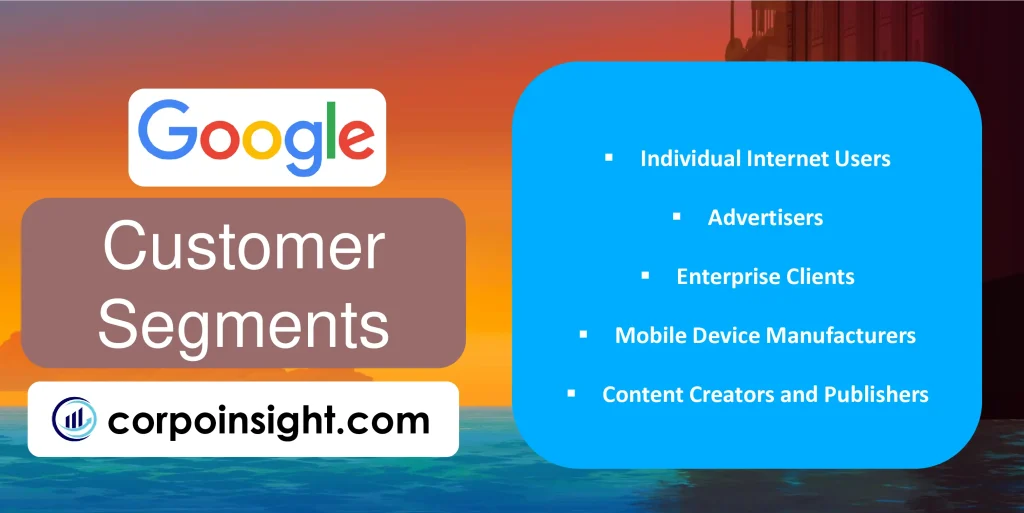
Individual Internet Users: Google’s primary segment, comprising billions of daily users who rely on its search engine, email services, and mobile operating system; for instance, as of 2023, Google processes over 8.5 billion searches per day, showcasing its vast reach across diverse demographics and geographies.
Advertisers: A crucial revenue-generating segment, including businesses of all sizes that leverage Google Ads to reach potential customers; notably, Google’s ad revenue reached $224.47 billion in 2023, highlighting the platform’s dominance in digital advertising and its appeal to marketers seeking targeted exposure.
Enterprise Clients: This segment encompasses organizations utilizing Google Cloud Platform and G Suite (now Google Workspace) for their IT infrastructure and productivity needs; Google Cloud’s revenue grew to $26.28 billion in 2023, indicating strong adoption among businesses seeking scalable, cloud-based solutions.
Mobile Device Manufacturers: Companies that integrate Android OS into their devices form a significant segment, as Android commands over 70% of the global mobile operating system market share as of 2023, demonstrating Google’s extensive influence in the mobile ecosystem.
Content Creators and Publishers: This segment includes YouTube partners, website owners using AdSense, and app developers on the Google Play Store; YouTube alone boasts over 2 billion logged-in monthly users, underscoring the platform’s importance for content creators and Google’s role in the creator economy.
Value Proposition – Google Business Model Canvas
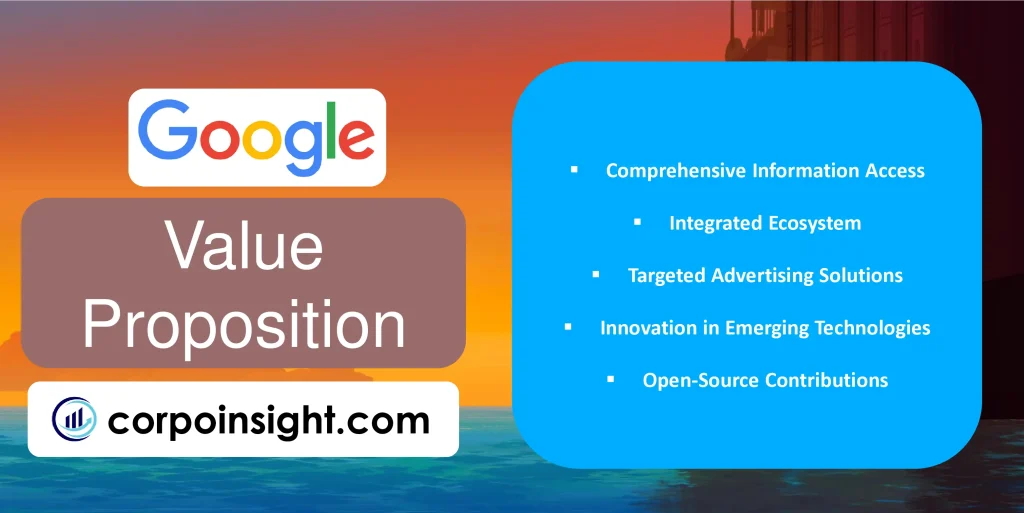
Comprehensive Information Access: Google’s search engine, processing over 8.5 billion daily searches as of 2023, offers users unparalleled access to global information; this, coupled with services like Google Scholar and Google Books, provides a vast knowledge repository that caters to diverse informational needs, from casual inquiries to academic research.
Integrated Ecosystem: Google’s suite of interconnected products, including Gmail, Google Drive, and Google Workspace (used by over 3 billion users), offers seamless integration and productivity enhancement; this ecosystem, which extends to mobile devices through Android OS (powering over 3 billion active devices), provides users with a cohesive digital experience across multiple platforms.
Targeted Advertising Solutions: For advertisers, Google’s extensive user data and sophisticated algorithms enable highly targeted ad placements; with Google Ads generating $224.47 billion in revenue in 2022, the platform demonstrates its effectiveness in connecting businesses with potential customers, offering a compelling ROI for marketing investments.
Innovation in Emerging Technologies: Google’s continuous investment in cutting-edge technologies, such as artificial intelligence and machine learning, enhances user experiences across its products; for instance, Google’s AI-powered features in search and Google Workspace showcase the company’s commitment to leveraging advanced tech for practical, user-centric applications.
Open-Source Contributions: Google’s significant contributions to open-source projects, including the Android operating system and the TensorFlow machine learning framework, provide value to developers and businesses worldwide; this open approach fosters innovation and collaboration within the tech community, while simultaneously expanding Google’s influence in key technological domains.
Revenue Streams – Google Business Model Canvas
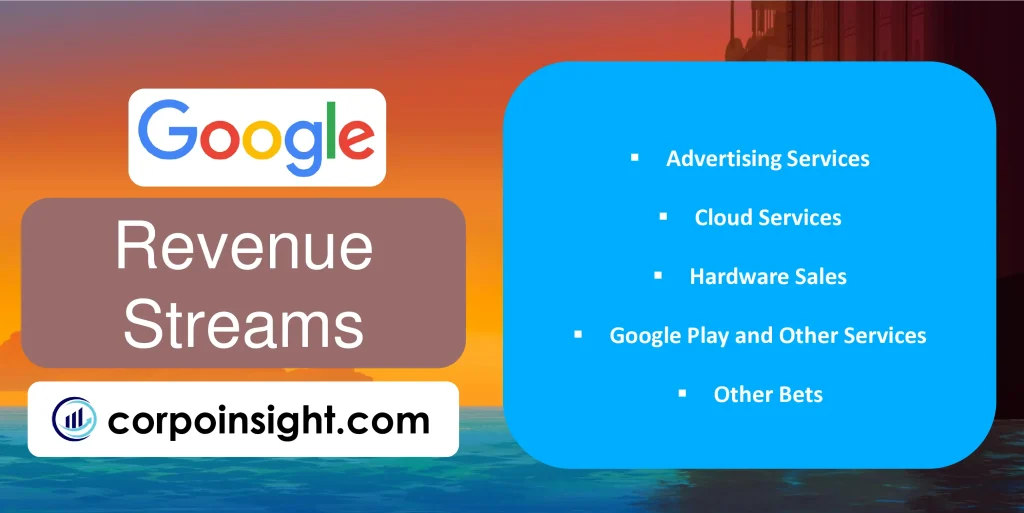
Advertising Services: Google’s primary revenue stream, encompassing Google Ads and YouTube ads, generated a staggering $224.47 billion in 2022, accounting for approximately 80% of Alphabet’s total revenue; this dominance in digital advertising is fueled by Google’s vast user base and sophisticated targeting algorithms, which enable advertisers to reach specific audiences effectively.
Cloud Services: Google Cloud, offering a suite of cloud computing services, infrastructure, and platform solutions, has shown remarkable growth, with revenue reaching $26.28 billion in 2022, a 37% increase year-over-year; this rapid expansion underscores the increasing adoption of Google’s cloud technologies by businesses seeking scalable and innovative IT solutions.
Hardware Sales: Although not as substantial as advertising, Google’s hardware division, which includes products like Pixel phones, Nest smart home devices, and Fitbit wearables, contributes significantly to its diversified revenue streams; while specific figures are not disclosed, the segment falls under “Google other revenues,” which totaled $29.15 billion in 2022.
Google Play and Other Services: Revenue from Google Play Store app sales, in-app purchases, and digital content, along with other services like YouTube Premium subscriptions, also falls under the “Google other revenues” category; this diverse portfolio of digital offerings helps Google maintain a strong presence in the app economy and digital content market.
Other Bets: While currently not a major revenue generator, Alphabet’s “Other Bets” segment, which includes innovative projects like Waymo (self-driving technology) and Verily (life sciences research), represents potential future revenue streams; in 2022, this segment generated $1.06 billion in revenue, showcasing Google’s investment in long-term, potentially disruptive technologies.
Channels – Google Business Model Canvas
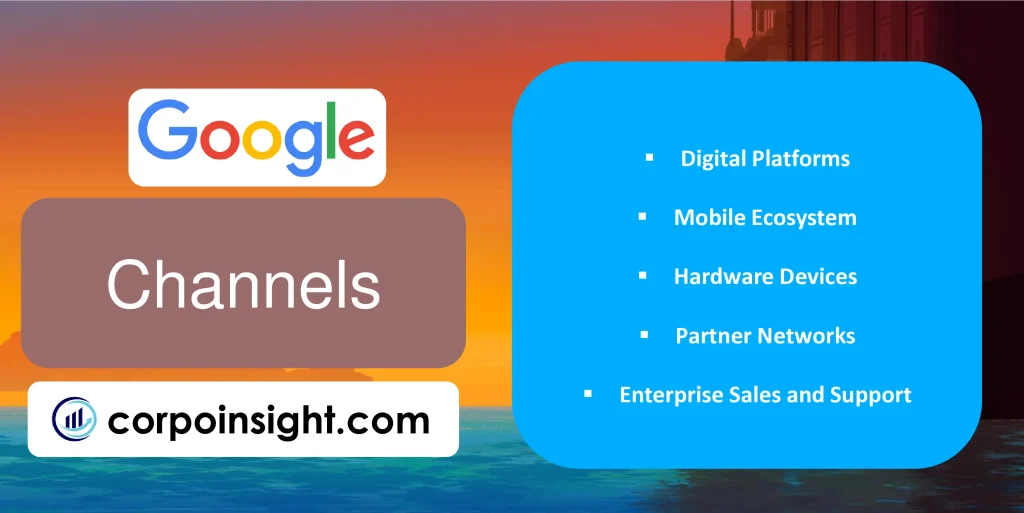
Digital Platforms: Google’s primary channel is its suite of digital platforms, including the ubiquitous search engine, which processes over 8.5 billion searches daily, and YouTube, boasting 2.7 billion monthly active users as of 2023; these platforms serve as crucial touchpoints for users to access services and for advertisers to reach their target audiences.
Mobile Ecosystem: The Android operating system, powering over 3 billion active devices globally, serves as a vital channel for Google to distribute its services and apps; through the Google Play Store, which facilitated 111.3 billion app downloads in 2022, the company maintains a strong presence in the mobile market and ensures widespread access to its offerings.
Hardware Devices: Google’s line of hardware products, including Pixel phones, Nest smart home devices, and Chromebooks, act as physical channels for service delivery; while specific sales figures are not disclosed, the hardware division contributes to the “Google other revenues” category, which generated $29.15 billion in 2022.
Partner Networks: Google extends its reach through a vast network of partners, including the Google Display Network spanning over 2 million websites and reaching over 90% of internet users worldwide; this network, coupled with partnerships with device manufacturers and telecom providers, significantly amplifies Google’s market presence and service accessibility.
Enterprise Sales and Support: For cloud services and enterprise solutions, Google employs direct sales teams and provides dedicated support channels; this approach has contributed to Google Cloud’s impressive growth, with revenue increasing by 37% year-over-year to reach $26.28 billion in 2022, indicating strong adoption among business clients.
Customer Relationships – Google Business Model Canvas
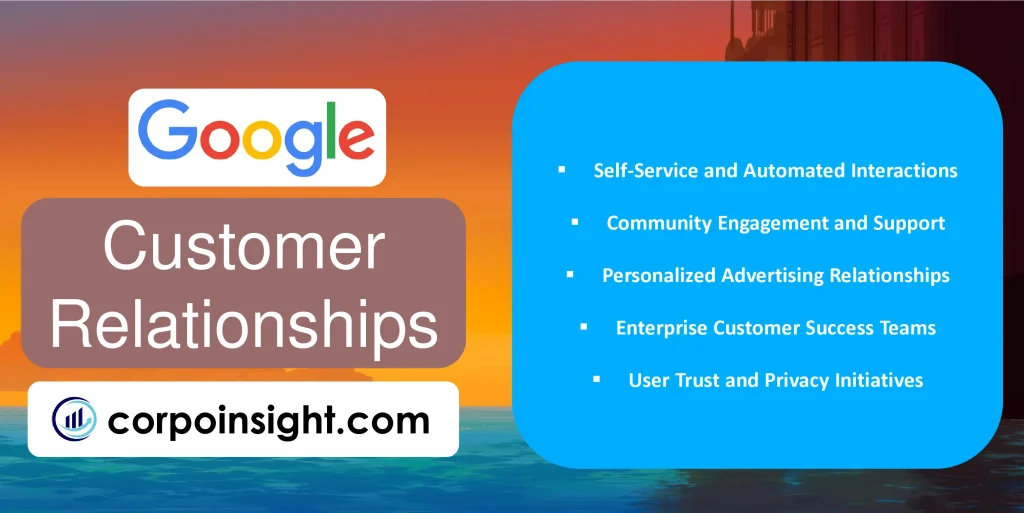
Self-Service and Automated Interactions: Google’s core services, such as search and Gmail (with over 1.8 billion active users), are designed for seamless self-service, allowing users to interact with the platform independently; this approach, supported by AI-driven features like Smart Compose (which saves users 2 billion characters weekly), enhances user experience while minimizing the need for direct human intervention.
Community Engagement and Support: Google fosters user communities through platforms like Google Developer Groups, which hosts over 1,000 chapters worldwide, and the Google Product Experts Program; these initiatives, complemented by extensive online documentation and forums, create a collaborative ecosystem where users can find support, share knowledge, and contribute to product improvements.
Personalized Advertising Relationships: For its advertising clients, Google offers a mix of automated tools and personalized support; while small businesses often utilize self-service platforms, larger advertisers benefit from dedicated account managers and tailored strategies, contributing to Google’s advertising revenue of $224.47 billion in 2022.
Enterprise Customer Success Teams: Google Cloud’s rapid growth (37% year-over-year increase in 2022) is partly attributed to its focus on enterprise customer relationships; through dedicated success teams, technical account managers, and industry-specific solutions, Google provides high-touch support to its cloud customers, ensuring successful adoption and implementation of its services.
User Trust and Privacy Initiatives: Recognizing the importance of trust in customer relationships, Google has implemented various privacy initiatives, such as the Privacy Sandbox project and the commitment to phase out third-party cookies in Chrome by 2024; these efforts aim to balance personalized experiences with user privacy, demonstrating Google’s responsiveness to evolving customer concerns in the digital age.
Key Activities – Google Business Model Canvas
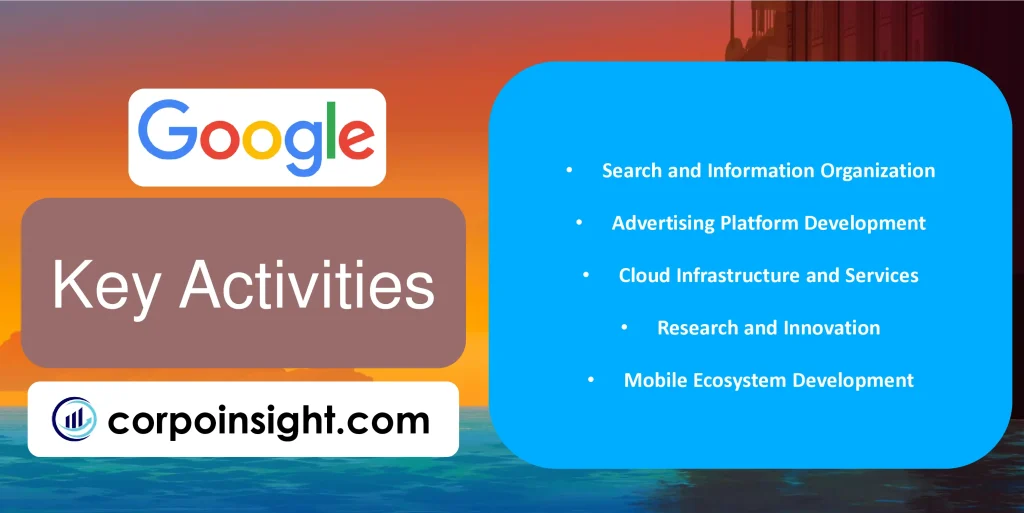
Search and Information Organization: At its core, Google continually refines its search algorithms, processing over 8.5 billion searches daily; recent innovations include the integration of AI-powered features like Multisearch and Lens, which allow users to search using images and text simultaneously, enhancing the search experience and maintaining Google’s dominance in information retrieval.
Advertising Platform Development: Google’s primary revenue driver involves continuous improvement of its advertising platforms, including Google Ads and AdSense; in 2022, these efforts contributed to a substantial $224.47 billion in advertising revenue, with recent focus on privacy-preserving ad technologies like FLoC (Federated Learning of Cohorts) to adapt to evolving data protection regulations.
Cloud Infrastructure and Services: Google Cloud, growing 37% year-over-year in 2022, requires ongoing development and maintenance of cloud infrastructure; this includes expanding data centers globally (with 35 cloud regions as of 2023) and enhancing services like BigQuery and Vertex AI to meet enterprise demands for scalable, AI-driven cloud solutions.
Research and Innovation: Google’s commitment to innovation is evident in its R&D spending, which reached $39.5 billion in 2022; key focus areas include artificial intelligence, quantum computing, and sustainable technologies, with projects like the AI model PaLM 2 and the development of more energy-efficient data centers showcasing Google’s dedication to pushing technological boundaries.
Mobile Ecosystem Development: Maintaining and evolving the Android operating system, which powers over 3 billion active devices globally, remains a crucial activity; this involves regular updates, security enhancements, and feature developments, such as the introduction of Android 13 in 2022, which focused on improved privacy controls and personalization options for users.
Key Resources – Google Business Model Canvas
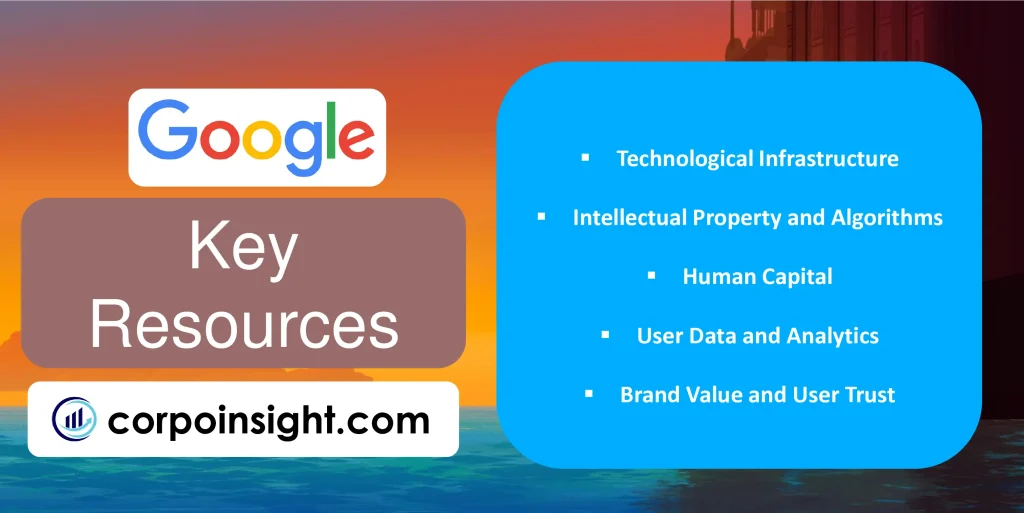
Technological Infrastructure: Google’s vast network of data centers, comprising 23 regions and 70 zones globally as of 2023, forms the backbone of its services; this infrastructure, coupled with cutting-edge hardware like the tensor processing units (TPUs) for AI computations, enables Google to process over 8.5 billion daily searches and support its cloud services efficiently.
Intellectual Property and Algorithms: Google’s proprietary algorithms, including the PageRank algorithm for search and the recommendation systems for YouTube, are crucial assets; with over 39,000 patents granted as of 2023, Google’s IP portfolio not only protects its innovations but also drives its competitive advantage in areas like machine learning and artificial intelligence.
Human Capital: Google’s workforce of over 190,000 employees (as of 2022) represents a key resource, with the company consistently ranking among top employers; this talent pool, comprising world-class engineers, researchers, and business professionals, fuels Google’s innovation engine and is supported by substantial investments in employee development and wellbeing.
User Data and Analytics: The vast amount of user data collected across Google’s services provides invaluable insights for product improvement and targeted advertising; while exact figures are not disclosed, Google’s ability to leverage this data contributed to its $224.47 billion advertising revenue in 2022, showcasing the critical nature of this resource.
Brand Value and User Trust: Google’s brand, valued at $231.4 billion in 2023 by Brand Finance, is a significant intangible asset; this brand value, built on user trust and product reliability, enables Google to maintain its market leadership and expand into new areas, as evidenced by the growing adoption of Google Cloud services among enterprise customers.
Key Partners – Google Business Model Canvas
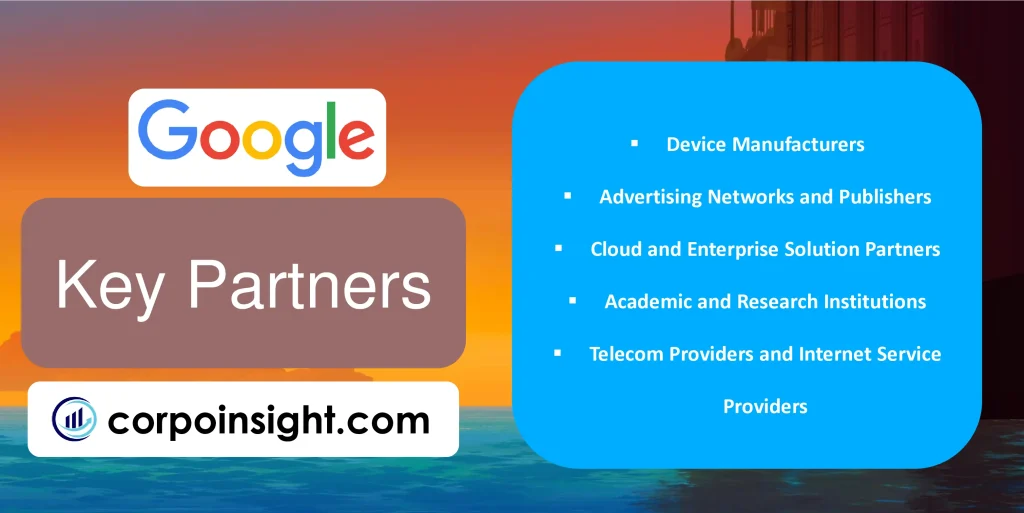
Device Manufacturers: Google’s partnerships with smartphone manufacturers like Samsung, Xiaomi, and others are crucial for Android’s dominance, powering over 3 billion active devices globally; these collaborations, which include the Android One program for entry-level devices, ensure Google’s services reach a vast user base across diverse markets and price points.
Advertising Networks and Publishers: Google’s extensive network of advertising partners, including millions of websites in the Google Display Network, is vital for its ad business; this ecosystem, which generated $224.47 billion in ad revenue in 2022, relies on partnerships with publishers, app developers, and content creators to extend Google’s advertising reach beyond its own properties.
Cloud and Enterprise Solution Partners: Google Cloud’s partner ecosystem, comprising over 100,000 partners globally, is instrumental in its growth strategy; these partnerships, ranging from system integrators like Accenture to independent software vendors, contributed to Google Cloud’s 37% year-over-year revenue growth in 2022, enhancing its ability to serve diverse enterprise needs.
Academic and Research Institutions: Collaborations with universities and research organizations worldwide support Google’s innovation initiatives; for instance, the company’s partnerships with institutions like Stanford University and MIT on quantum computing research exemplify how these alliances drive advancements in cutting-edge technologies, reinforcing Google’s position at the forefront of technological innovation.
Telecom Providers and Internet Service Providers: Google’s partnerships with telecom companies and ISPs are crucial for initiatives like Google Fiber and global internet accessibility projects; these collaborations, such as the Equiano subsea cable project connecting Africa to Europe, demonstrate Google’s commitment to expanding internet infrastructure and, consequently, its potential user base in emerging markets.
Cost Structure – Google Business Model Canvas

Research and Development: Google’s substantial R&D investment, totaling $39.5 billion in 2022, underscores its commitment to innovation; this expenditure, which has consistently grown year-over-year, fuels advancements in AI, quantum computing, and other cutting-edge technologies, ensuring Google’s competitive edge in rapidly evolving tech landscapes.
Infrastructure and Data Centers: The company’s global network of data centers and technical infrastructure represents a significant cost, with ongoing expansions and upgrades; while specific figures are not disclosed, Google’s parent company Alphabet reported $31.5 billion in capital expenditures for 2022, a large portion of which was attributed to investments in servers, data centers, and office facilities.
Traffic Acquisition Costs (TAC): A major component of Google’s cost structure, TAC refers to the fees paid to distribution partners and others who direct traffic to Google’s search engine and advertising networks; in 2022, Google’s TAC amounted to $45.5 billion, reflecting the company’s reliance on partnerships to maintain its vast reach and market dominance.
Employee Compensation and Benefits: As a knowledge-intensive company, Google invests heavily in its workforce; with over 190,000 employees as of 2022, the company’s costs for salaries, stock-based compensation, and benefits are substantial, though exact figures are not separately disclosed in financial reports.
Content Acquisition and Partnerships: Particularly relevant for YouTube and Google Play, content acquisition costs represent a growing expense as Google competes in the streaming and digital content markets; while not explicitly broken out in financial reports, these costs are part of Google’s strategy to enhance its content offerings and maintain user engagement across its platforms.
Summary of Google Business Model Canvas
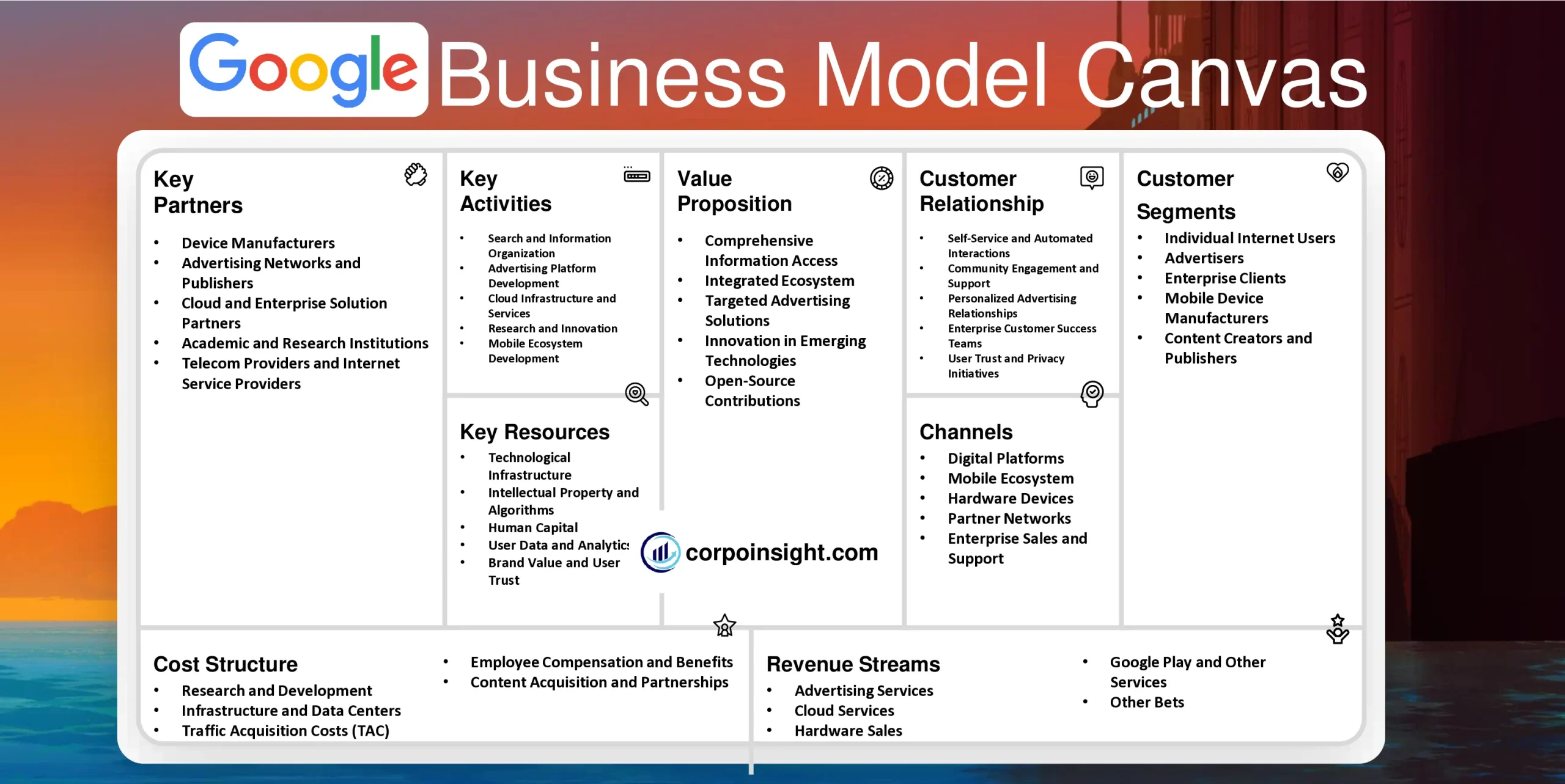
Conclusion on Google Business Model Canvas
Google’s Business Model Canvas reveals a robust and diversified strategy, leveraging its dominant search and advertising platforms while expanding into cloud services, hardware, and emerging technologies. The company’s success is built on a vast user base, cutting-edge technology infrastructure, and a culture of innovation. Google’s ability to monetize user data through targeted advertising, coupled with strategic partnerships and continuous R&D investments, ensures its position as a tech leader. However, evolving privacy concerns and regulatory challenges present ongoing considerations for the company’s future growth and adaptability.

This is Ahsanul Haque, someone very passionate about digital marketing, SEO, and Data Analytics and founder of the Analytics Empire and currently pursuing my major in marketing at Bangladesh University of Professionals.






